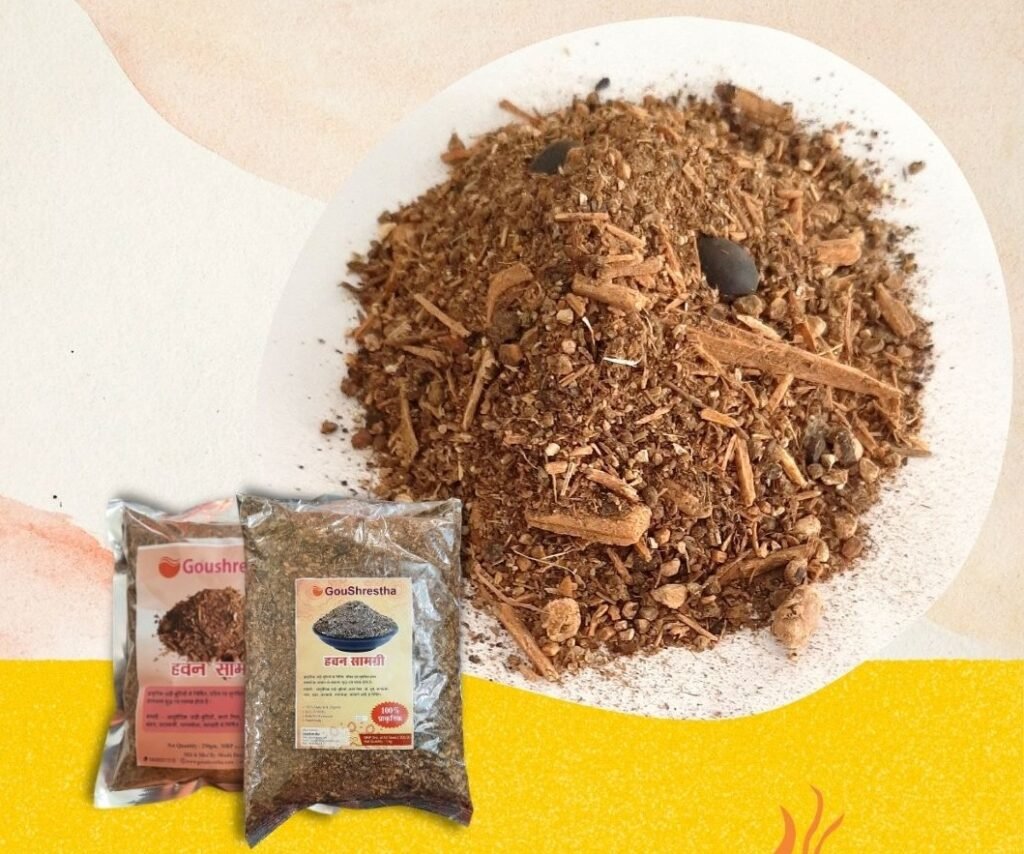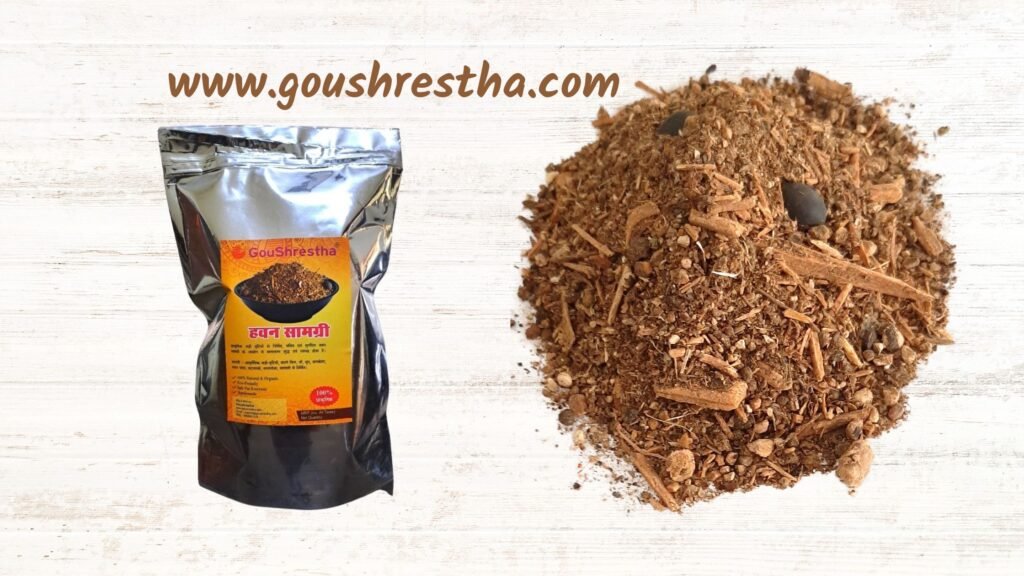Properties of Hawan Samagri
HAWAN SAMAGRI
In India or any Hindu, god-fearing family, a HAWAN is a must on different occasions. Be it baby naming, a new house or building or a festival, a havan has the entire family sitting together while the pandit speaks the mantras. In this
A HAWAN SAMAGRI has ingredients or samagri like leaves, herbal roots, ghee, milk, seeds, incense and grains. It also has dry coconut, guggal, agar wood, amla, bach, bay leaves, green cardamom, cloves, chharil, haldi, deodar, dhawaiphool, dry eucalyptus leaves, kapoor kachari, nutmeg, and the list goes on.
BENIFITS OF HAWAN SAMGRI
It is not just the samagri but also the material of the vessel which is most of the time made of copper. The fire is prepared in a copper pyramid, also known as the havan kund. Substances like ghee, dried cow dung, jaggery, brown rice are burned while chanting mantras.
Hawan Samagri, which is used in the practice of Hawan (a Hindu ritual involving the offering of sacred materials into a consecrated fire), is believed to have several benefits. Here are some potential benefits associated with Hawan Samagri:

- Spiritual Purification: Hawan Samagri is believed to have purifying properties that cleanse the environment and create a positive spiritual ambiance. It is used to invoke the blessings of deities and seek their divine presence during the Hawan ceremony.
- Cleansing and Energizing the Atmosphere: The smoke generated from burning Hawan Samagri is considered to purify the surrounding air by dispelling negative energies, pollutants, and impurities. It is believed to create a harmonious and energetically charged atmosphere.
- Mental and Emotional Clarity: The aromatic fragrance of the herbs, resins, and other ingredients in Hawan Samagri is said to have a calming effect on the mind, promoting mental clarity and emotional well-being. It is believed to enhance focus, concentration, and positive thinking.
- Health Benefits: Some of the herbs and natural ingredients present in Hawan Samagri are known for their medicinal properties. The smoke from burning these ingredients may have antimicrobial, antiseptic, and insect-repellent properties, which can help purify the air and promote respiratory health.
- Stress Relief: Participating in a Hawan ceremony and being in the presence of the sacred fire, along with the aroma of Hawan Samagri, is believed to create a sense of calmness and relaxation. It is considered a form of stress relief and spiritual rejuvenation.
- Cultural and Traditional Significance: Hawan Samagri holds cultural and traditional significance in Hindu rituals and ceremonies. It is believed to connect individuals with their cultural heritage and foster a sense of spirituality, devotion, and reverence.
Here are some scientific benefits you must know of:
- Fire is more like a pesticide for your home
- Mantras are very relaxing and calming to the ears.
- Reduction of bacteria due to the burning of herbs.
- The ash of the yagna is an effective fertilizer.
- Removal of foul odours.
Best Hawan Samgri Hawan samagri making process
The process of making Hawan Samagri, also known as the sacred fire ritual mixture, involves gathering and combining various natural ingredients. Hawan Samagri is typically prepared by following traditional methods, and the exact ingredients may vary depending on regional customs and personal preferences. Here is a general overview of the process:

- Gathering Ingredients: Collect the required ingredients for making Hawan Samagri. These ingredients usually include a combination of herbs, woods, flowers, and other sacred substances. Common components may include ghee (clarified butter), camphor, sandalwood powder, dried cow dung cakes, jatamansi (spikenard), tulsi (holy basil) leaves, guggul (a resin), dried coconut husk, incense sticks, and various aromatic herbs.
- Cleaning and Drying: Ensure that the gathered ingredients are clean and free from any impurities. Remove any dirt, debris, or unwanted parts from the herbs and flowers. Allow the ingredients to dry naturally, as moisture can affect the quality and longevity of the Hawan Samagri.
- Grinding and Mixing: Once the ingredients are dry, grind them separately into a fine powder using a mortar and pestle or a grinder. Ensure that each component is ground to a consistent texture. After grinding, mix all the powdered ingredients in a clean and dry container. Use a gentle hand or a clean spoon to combine them thoroughly.
- Adding Fragrance: Some people prefer to add fragrant substances to enhance the aroma of the Hawan Samagri. This step is optional and depends on personal preferences. You can include fragrant elements like powdered dried flowers, rose petals, jasmine flowers, or any other scented herb or substance.
- Blessing and Intentions: As you prepare the Hawan Samagri, it is common for individuals to offer prayers and blessings, infusing the mixture with positive intentions and sacred energy. This step is subjective and can vary based on personal beliefs and customs.
- Storing: After the preparation is complete, store the Hawan Samagri in an airtight container to retain its freshness and aroma. It is recommended to store it in a cool and dry place away from direct sunlight.
When using the Hawan Samagri during a Havan or sacred fire ritual, it is customary to offer it to the fire while reciting prayers and chanting mantras. The fragrance and smoke produced by the burning Hawan Samagri are believed to purify the environment and create a spiritually uplifting atmosphere.
HAWAN SAMAGRI INGREDIENTS
HAWAN SAMAGRI is the blend of different herbal roots, leaves, grains, butter, milk, incense and seeds.
The main content in Havan Samagri are Agar Wood, Anwala, Bach, Baheda, Bawachi, Bay Leaves, Cardamom Green, Chharil, Cloves, Daru, Haldi, Deodar, DhawaiPhool, Dry Coconut or SookhaNariyal, Dry Eucalyptus leaves, Guggal or Guggul, Guruch, Harr or Harad, Howber, IndraJau, Jara Kush, JataMasi? or Balchhad, Kamal Gatta, Kapoor Kachari, Nag Keshar, Nagarmotha, Nutmeg, Red Sandal Wood, Sandal Wood, Sugandh Bala, Sugandh Kokila, Sugandh Mantri, Tagar Wood, Talish Patra, Tej Bal Wood, Tomad Bee.
HAWAN SAMAGRI when offered in the ablazed fire which disseminates in microform, in the air, to purify the environment besides activating the air as a disinfectant germicidal agent.
The ingredients of Hawan Samagri can vary depending on regional customs and personal preferences. However, here are some commonly used ingredients in Hawan Samagri:
- Ghee (clarified butter): Ghee is a key ingredient in Hawan Samagri. It is used to offer oblations into the sacred fire.
- Samidha (sacrificial wood): Samidha refers to small wooden sticks or twigs that are specifically used for the purpose of Hawan. These can be obtained from specific trees like mango, sandalwood, peepal, banyan, etc.
- Dried Herbs and Spices: Various dried herbs and spices are added to Hawan Samagri for their aromatic and purifying properties. Some common examples include:
- Dry fruits (such as almonds, raisins, cashews)
- Cardamom (elaichi)
- Cloves (laung)
- Cinnamon (dalchini)
- Camphor (kapoor)
- Nutmeg (jaiphal)
- Dry coconut (copra)
- Bay leaves (tej patta)
- Frankincense (guggul)
- Myrrh (rajat bhasma)
- Jaggery (gur)
- Sugar (shakkar)
- Fragrant Herbs and Flowers: Some fragrant herbs and flowers are added to Hawan Samagri to enhance the aroma and create a pleasant atmosphere during the ritual. These may include:
- Sandalwood powder (chandan)
- Rose petals (gulab ke phool)
- Jasmine flowers (chameli ke phool)
- Marigold flowers (genda ke phool)
For puja hawan yagya or any worship of god use best hawan samagri it will support nature also. so use our goushrestha hawan samagri to your worship and puja.
यह भी पढ़े – Cow Dung Dhoop Batti Benefits
For Order Pls visit goushrestha.com





One comment
Pingback:
Uses and Benefits of Hawan Samagri